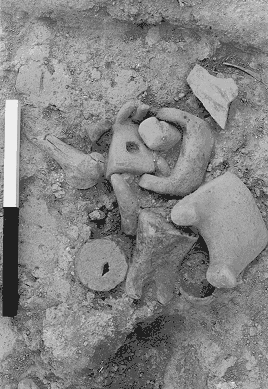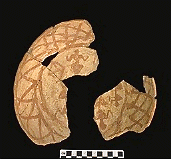The West Mound Excavations
by Jonathan LastDuring July and August 1998 a small team of British and Turkish archaeologists conducted excavations on the West Mound at Çatalhöyük to assess the nature and condition of the archaeological remains there. This work was carried out with the aid of a grant from the Wainwright fund.
The site is separated from the Neolithic East Mound by an old channel of the Çarsamba river. It dates to the Early Chalcolithic, the period which succeeds the Neolithic of the Konya plain. Many aspects of the architecture and material culture are similar to the earlier period, but there are also new developments.
We began work by re-opening areas within two trenches excavated by James Mellaart in 1961. In the northern trench (Trench I, Figure 5) we found the corner of a building, with mudbrick walls of very similar construction to those of the Neolithic. On the floor of the building were two grindstones.

Figure 14: Horned Potstand deposit uncovered in West Trench I |
From some red painted plaster fragments within the fill of the building there is evidence that walls were still being decorated in the Chalcolithic, but the main focus of symbolism and decoration had shifted to portable objects. In the top of the building fill we found a remarkable collection of clay artefacts in the form of small model 'potstands' and similar objects of unknown function, deliberately placed in association with fired and unfired pottery vessels and some animal bones. The unusual nature of these objects and the predominance of 'horned' forms with two prongs or projections suggest a special purpose to the deposit. They may represent a new expression of the horn symbolism seen in the bucrania of the Neolithic period, and were perhaps placed to mark the closure or demolition of the building. |
| In Trench II, to the south, we found a large pit which contained a great quantity of potsherds, painted with geometric designs in red and black. The most significant find was a pottery bowl decorated with a scene showing people dancing in front of a pair of larger figures. As well a this unique vessel, sherds form two other pots with painted human figures were found in the pit, while another piece from Trench I has moulded features in the shape of a face. The increase in the quantity and variety of ceramics in the Chalcolithic compared to the Neolithic suggests that the pottery had a greater significance, perhaps associated with new trade or exchange networks. Some unusual pieces with incised and impressed decoration suggest connections between Çatalhöyük and other regions of Turkey. | 
Figure 15: Chalcolithic Pot found in the West mound during the 1998 excavations |
Our excavations on the West mound have shown the site to be better preserved and more interesting than we previously thought. As well as the exceptional finds mentioned here, a full range of artefacts, faunal and botanical evidence was recovered which will allow us to compare Neolithic and Chalcolithic activities and begin to understand how lifestyles changed over the long term at Çatalhöyük.